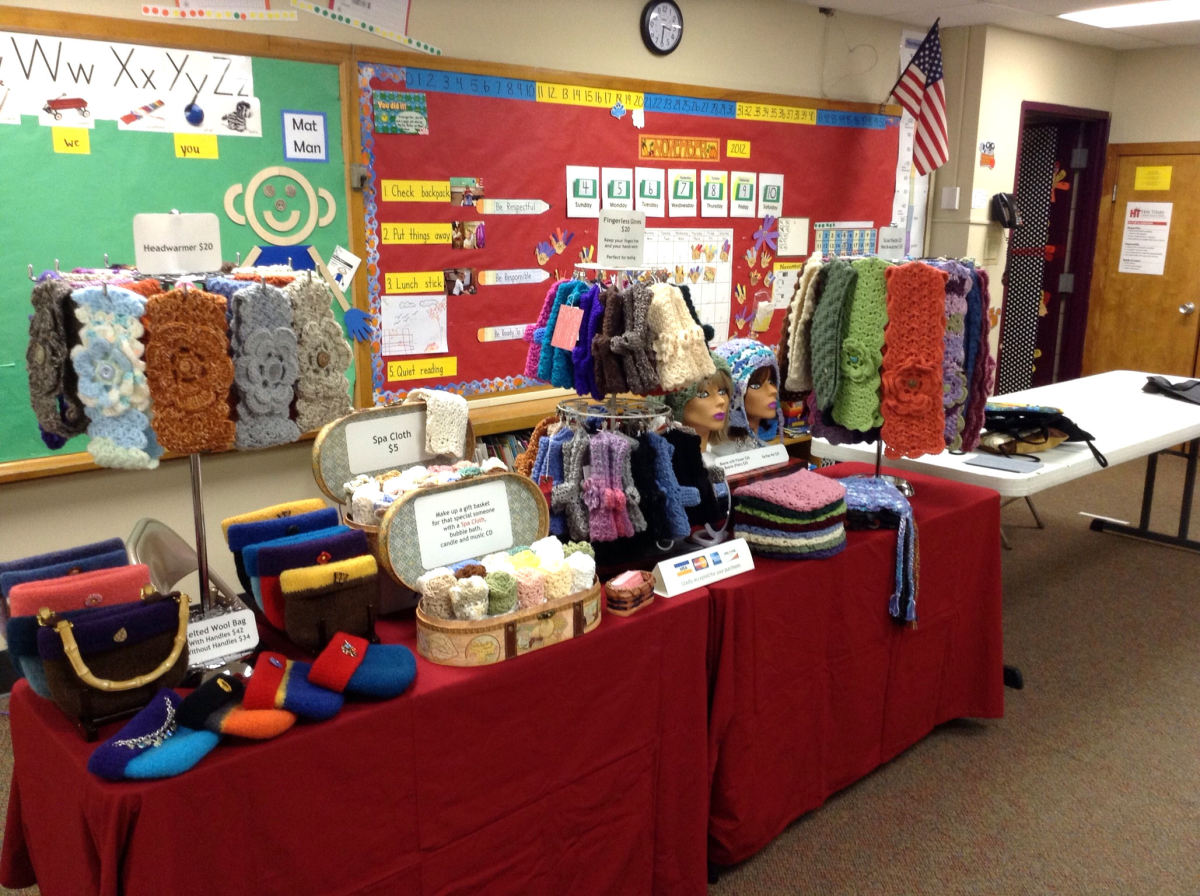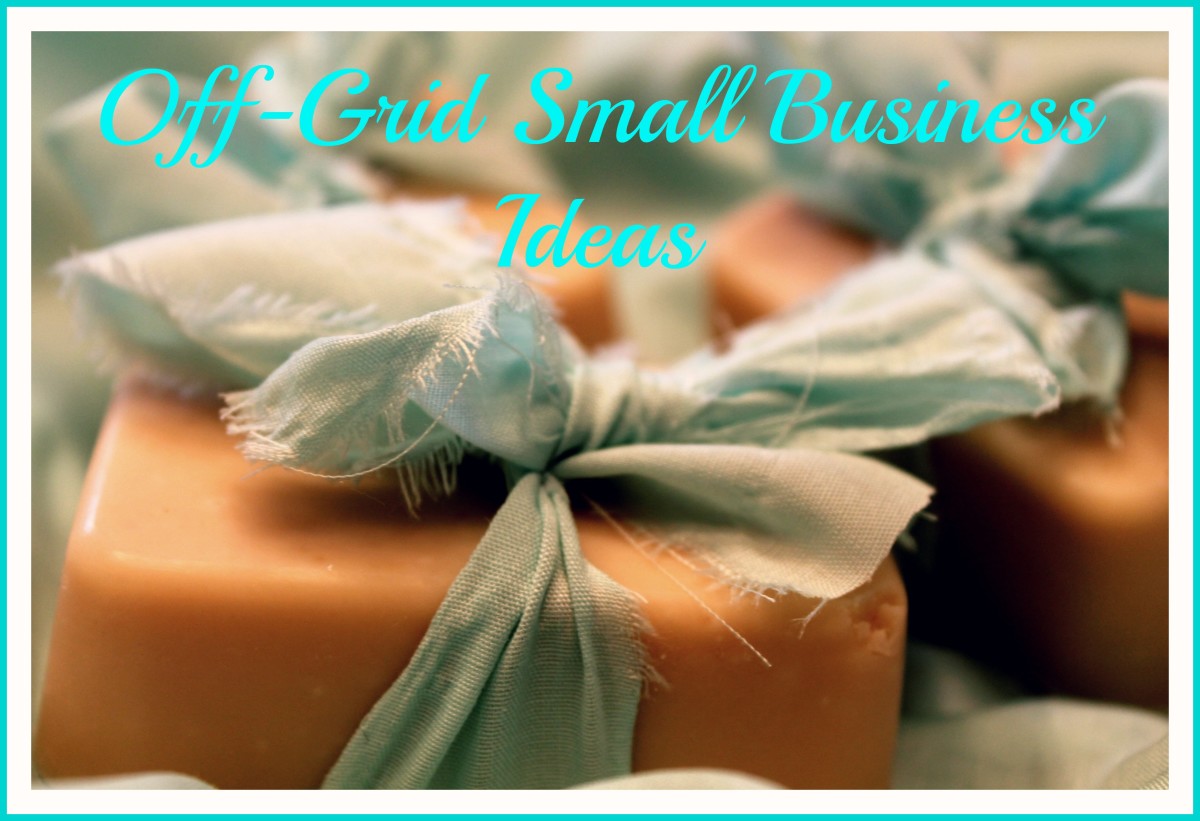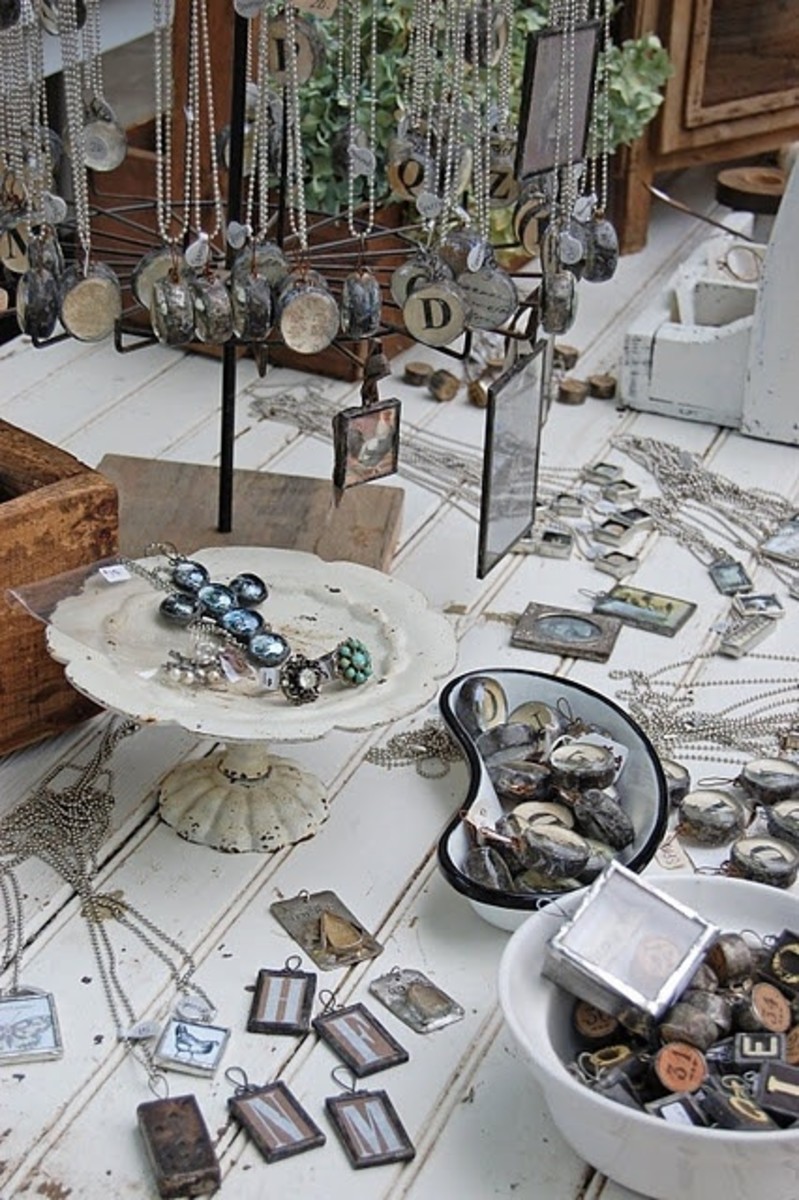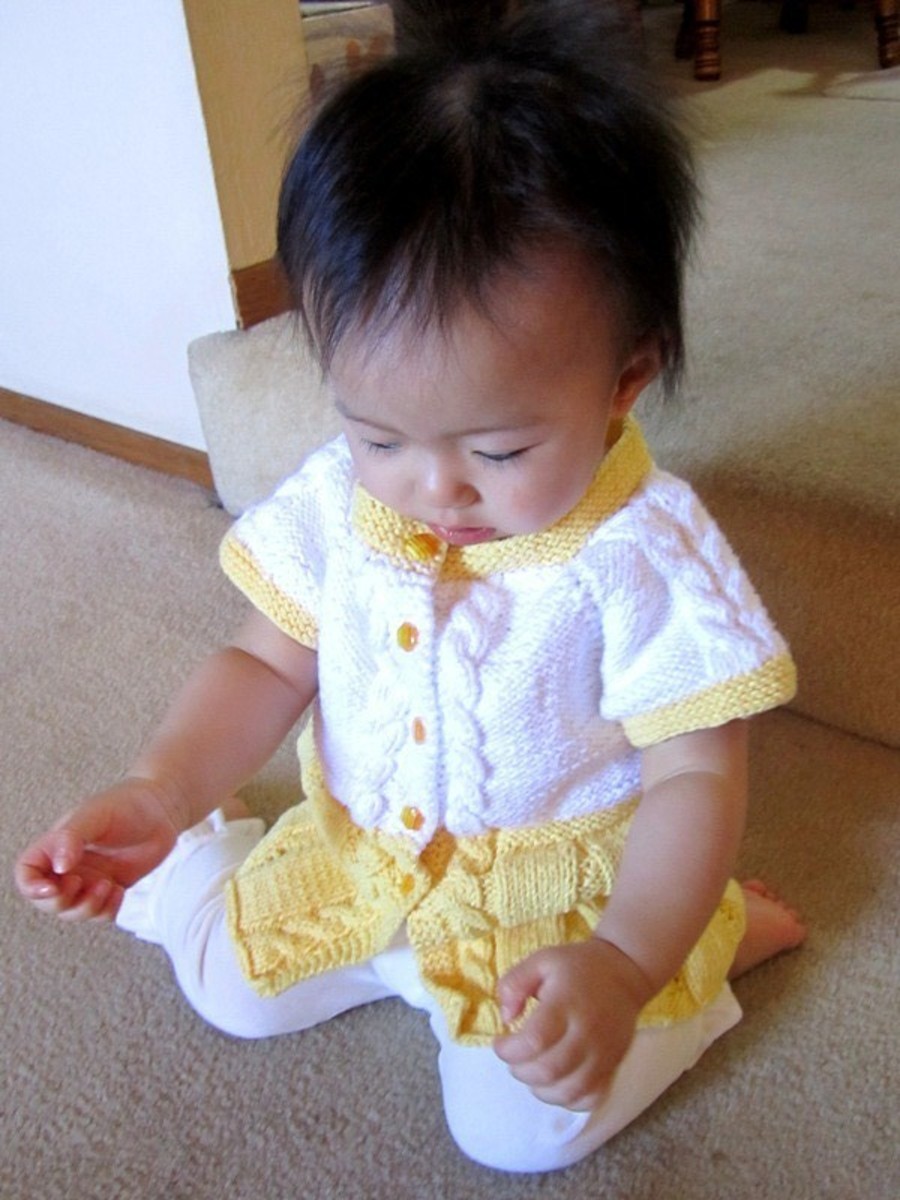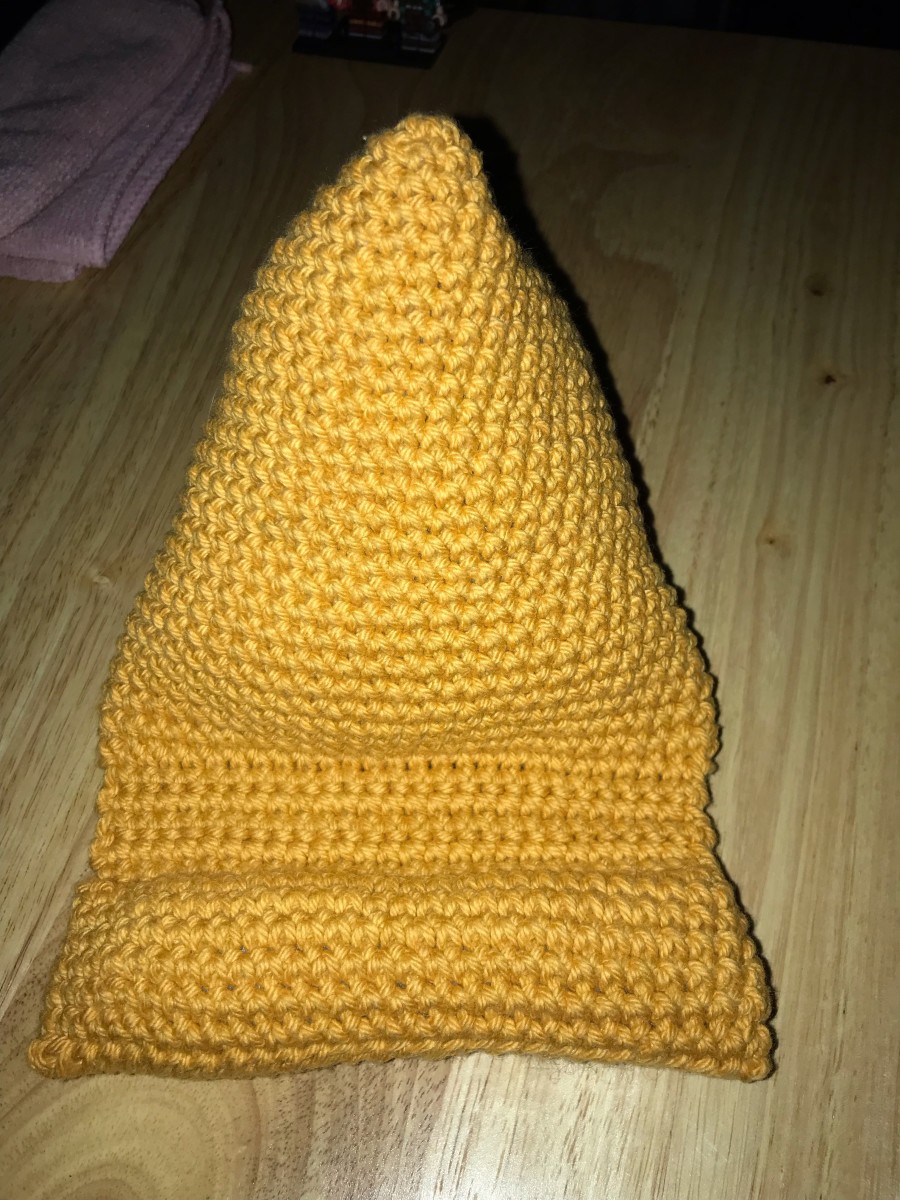All That Yarn - Craft Fairs
Stuff I've made.
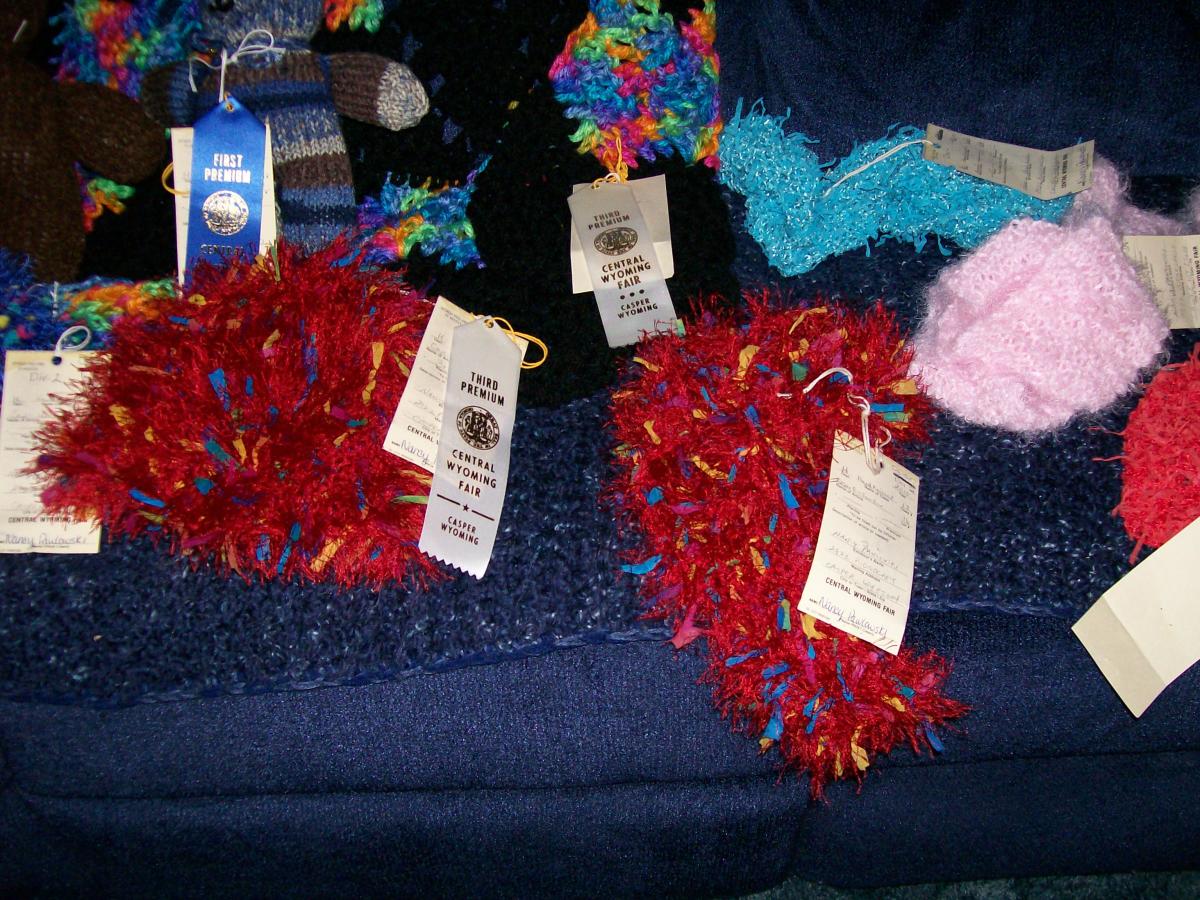
I'm "down" on craft fairs.
I don’t mean to be depressing about craft fairs, but I have not had good luck with any craft fairs that I have participated in. If it weren’t for my friend needing someone to help watch her booth I would not have bothered with trying to sell my wares at the same time.
I usually avoid participating in Craft Fairs. I also avoid going to visit them as I can usually make the things that I would be looking at, so it is not a good use of my time to take up the time of sellers who will not make a sale from me.
Read on and you will see why that is so.
It started over 30 years ago.
About 30 years ago I had the bright idea that I could make and sell cotton yarn dishcloths at a local craft fair. The table price was $25.00 and I had to provide my own table and chair for it. I made up a bunch of cotton dishcloths using the Lily Sugar and Cream cotton yarn. The cost per ball of yarn was about $1.00 each (maybe a little less on sale) and I could make 2 cloths per ball. I had ideas of getting rich from doing crochet and knitting.
I was teaching my college continuing education class at the time, so I told my students about the craft fair in hopes that they would help bring me some business. I do remember making a sample crocheted snowman (stuffed) complete with black top hat that was also crocheted. I managed to talk one of my students into buying it and I think that helped me cover the cost of the table. I didn’t sell many dishcloths at $1.00 each. Some customers said they could buy cheap ones in the store for so much less. Ok, but they weren’t going to last as long as these and were not hand made. I didn’t do well with sales, and that was the last craft fair until the fall of 2014.
Craft Fairs tried again in 2014
I helped out a friend that was going to sell some books that she had illustrated. She was going to try selling them at a few local craft fairs, as she had started selling them at a summer music festival and thought craft fairs would be the way to go to get them sold.
She had tried offering her books to local bookstores in order to let them do the selling, but they would only take one copy to have on display. She had started with her own book on Amazon as a Kindle book, but it was difficult to find and she didn’t make any sales except to friends and relatives.
She had started her illustrating career by drawing the pictures for books by a local doctor who considers himself an author. He helps out by paying half of the craft fair table fee as any of his books (she illustrated) that sell would be 100% paid back to him. She only keeps what she sells of her one book that her husband authored and she illustrated over several years.
I offered to pay half of the table or booth costs but she insisted that she cover it as the author of the books paid for half the table (but he did not show up to help out at any of the three craft fairs) while she paid the other half of the table cost. Since all the money for the books that he wrote and she sold went to him, she was only out two days of her time sitting at the table at each of the three craft fairs.
She also made some “zombie Santa” ornaments to sell to fans of the TV show “The Walking Dead”, and some Dios de la Muertos ornaments, which sold fairly well. She made them using 6” plastic skeletons she got at the dollar store, painted and dressed in felt clothing. She also put them on eBay and they sold better on there than they did at the craft fairs.
She told me I could bring my fuzzy knit scarves to sell and be there to help her out. I had knit up some sample scarves for a class, and when the class was not offered I made up a few more so I had about 30 to sell. Since it was a “2-hour” scarf pattern, it didn’t take me much time to make up a bunch more. I also tried my hand at a few other novelty yarns like Bernat Boa which is super soft and slippery. My others, made for the class, were one ball of Lion Brand Boucle and one ball of Lion Brand Fun Fur. I also mixed the Fun Fur with the Boa and had some striking results. I had purchased a mystery box and gotten several skeins of the same shade of chenille, so I made up two with that yarn.
Armed with my 30 scarves, I set up my displays on one end of the table. I had purchased a free standing coat rack to display the scarves since they look better hanging up than folded and stacked on a table. I also purchased a handbag rack for setting on the table to show off the shorter scarves. So I was already to show off my wares and have people ooohh and aaahh over them.
Some of the patterns came out a lot longer than I thought they would, but I figured there were lots of opinions on what a proper length for a scarf could be, so I didn’t take out any of them and start over. I had wide ones and narrow ones, long, short, and all sorts of color combinations of fur and boucle. I figured I had something for every one who might want to buy a handmade fuzzy or soft scarf.
No Sale...
Well, the first craft fair was in October. I sold NOTHING the entire weekend, except for helping to sell my friend’s books. I was discouraged as there were a lot of people who stopped to look at the colors and “pet” the chenille or the boa yarn or the fur scarves.
The next fair was in November and I thought that with Christmas getting closer maybe I’d do better with sales. The first day came and went, no sales at all, again. The second day was winding down in the afternoon and I finally sold one. Then another and another until I had sold a total of 4 scarves. I wouldn’t have made enough to cover the cost of the table that way if I had been on my own.
Discouraged again, I went with my friend to the December craft fair with no expectations of selling anything. The afternoon of the first day one lady stopped and looked through the scarves on the coat rack. By the time she was done she had picked out 3 scarves to purchase. I was a bit in shock! She cleaned out my brown boa selection and a couple others in blacks and browns.
The next day I had one person I knew talk me down from $20 to $15 for my red and black boa scarf. So I only sold 1 that last day. So another 4 scarves sold, and I still had plenty of inventory on hand.
I did get a request for a camo colored scarf, but I had to tell her that the yarn I had purchased did not come in those colors. I also had one lady looking for “just dark brown” ones and none of the ones I had fit what she was looking for. Another lady was looking for the crocheted or knitted headbands with a flower on them. I had nothing like that sitting out so I don’t know why she even asked about it.
Just from my observations of the local craft fairs. People sat in their spaces and worked on projects like crocheting edging on fleece blankets, or knitting another hat to put up for sale. There didn’t seem to be a lot of purchasing going on. A lot of standing and waiting for customers to come along, or talking with the people on either side of their space in order to fill the empty time waiting. It may be that the economy has not recovered enough around here for people to spend more money on hand made goods when they can go to the discount store and get things for so much less. They miss out since hand made is often better than store bought stuff, but a lot of people look at the price and not the quality of the item.
Other thoughts on making things.
Sometimes people start a hobby and then end up with more “product” than they can give away as gifts, so they try selling it at a craft fair instead. I don’t want to discourage people from participating in craft fairs. There are lots of specialty items that can only be found at craft fairs, like homemade products, woodworking items, handmade jewelry, or foods.
Some people think you can make a lot of money selling your stuff. They don’t realize that the cost of a hand knit or crochet item is often more than the price reflects when it is for sale. The rule of thumb that I once heard (for knit or crochet items) is to double the cost of materials. When you put several hours or days into making an afghan or a teddy bear or a scarf, double the materials cost doesn’t even come close to covering any of your time unless you count just a few pennies per hour (or even pennies per day) for labor. It is more of a sideline than a career, and definitely not a full time paying job. I read up on a lot of books for selling crafts back in the 1970s and 1980s. Materials were cheaper back then, so a little more money was likely from craft fairs but not a lot.
I had someone once tell me they were looking forward to retirement when they could devote more time to crafts. I hope they were not thinking that they’d make a living at it. Just doing it for the benefits you get from it is better than doing it with the goal of making money. There are studies going on that are showing the benefits from knitting and crocheting as far as stress relief and keeping fingers nimble. It also showed that doing crafts is beneficial to the person for a variety of reasons. Also, places online like etsy.com and other hand-made item websites can be helpful with selling crafts.
I once had a gal ask me to make her a Dr. Who scarf as she had looked at the online sellers and found it cost over $200 for one. I explained to her that the time and materials would probably cost at least that much, and with only a month to Christmas I told her I could not possibly make what she wanted in less than 6 months time. I told her that searching the internet for one that was not hand made would probably be more in her price range. I don’t know if she did, but I did some searching on my own and found some on Amazon.com that were less than $200, but still considerably expensive.
I know I tried selling my knit teddy bears in a yarn shop. People kept telling me how cute they were and how they’d like to have one. I took a couple bears to the local fair and won some ribbons. Then I took about 5 bears to the yarn shop and priced them at $10.00 each. The owner and I both thought $10.00 per bear was a reasonable price. Well, I only sold ONE of the bears from the yarn shop. After a year of the bears just sitting on a shelf in the shop, I ended up taking them back home and then donating them to a charity.
Consignment shop disaster
Consignment shops were big in the 1980s, I know since I tried selling some of my items at one. I lost all of my items when the shop suddenly closed and I could not contact the owner to get any of them back. I was not only out all my time and materials, I was out of any money that I could have made from those sales. I decided not to do that again.
One of the items I had put in there were because someone asked me to make them 40 braided Tandy lace key chains and then they had to back out of paying me for them. So I had 40 key chains and no one to buy them or pay me back for all that work. I made some hangers with crochet covers (like I was teaching in my class) and put them for sale at that consignment shop as well. I also think I had cotton dishcloths in with all those other items. I think I only got one check for $5.00 when she sold up to that amount (per the contract I had signed). I don’t think she advertised and the location was off the main downtown so it was not near the foot traffic it needed to be profitable. Lots of problems and few opportunities probably caused it to close.
I also had a university professor that talked me into making some tatted bookmarks to sell at her table at some event. She was from out of town and I mailed them to her. I never heard back from her, even after writing her a few times to inquire what happened to the tatting and if she ever sold any of it. I also asked her to send them back if she didn’t sell them or to send me the money for them if she wanted to keep them. Not a word, and no one that I knew who knew her could tell me how to contact her after she retired from the university.
Here is a list of “Things to Know" when doing a Craft Fair.
- Have enough “product” to sell, but not so much that your booth/table/area looks like a bargain basement sale. A variety of colors, sizes, and styles is helpful. But be sure you don’t over do it. Displays should be neat and tidy.
- Price things so that you can sell them, but not so low that you can’t make your booth price back in one day.
- Most craft fairs are seasonal, make your regular year-round product but also include something seasonal (like crochet snowflakes for one that is closer to Christmas or crochet bunnies for one closer to Easter).
- Be prepared to spend money for a good booth space, and sign up early. The ones on the ends rarely get enough traffic if you are in a long area. Try for one near the middle of the floor unless you need a lot of space then get 2 spaces with one being an end or corner if the sale floor is rectangular. The longer you wait the less choice you will have for a space location, or maybe not be able to get in at all. Some craft fairs have waiting lists for people who want to sell there, and you might not get in for that one.
- Long hallway ones are harder to gauge traffic, but the middle is where most people either start or end before they will walk the full length of the hallway.
- Outside ones need to have a cover or shelter in case of bad weather. (watch out for loose dogs who may want to “mark” your table)
- Inside craft fairs may not be climate controlled. Be prepared to keep warm in the winter with something other than a space heater as most fairs will not allow them. Try chemical hand warmer packets in your pockets for your hands, or thick socks inside your boots. Don’t be afraid to bring a lap robe or small warm blanket for your lap. Dress in layers so you can shed some if the temperature is hot, and add on as it cools off (and the sun moves over the building).
- Booth prices can sometimes vary by the location in the fair. Also, they may charge more for “commercial vendors” than they do for “homemade craft vendors”.
- Be prepared to collect and report sales tax (if applicable) as you are a “seller” and will have to report local sales tax for your sales. If you don’t have information on sales tax rules and regulations, contact your state’s department of revenue about it. Most can be found online with an email address for contacting them. AND be prepared with your information for IRS taxes. There is some leeway for “hobby” sales, due to loss rather than profit, but if you sell a certain amount you will be required to submit federal taxes for your income.
- Keep track of sales on a spreadsheet. That way you can track what sells and what doesn’t after each craft fair ends. It also makes totaling your profits easier, and provides written records for taxes.
- Have enough cash (change) on hand as some people like to bring $100 and $50 bills and pay for small items under $10.
- If you want to take credit cards, get a smartphone or tablet attachment that reads credit cards, like Square or PayPal or Amazon card swipers. You will be charged per credit card transaction and sometimes a seller fee, so make sure to adjust your prices to cover this extra expense. If you don’t accept credit cards you might lose out on bigger sales. Most people don’t carry much cash any more. Locate the nearest ATM in case a customer wants to get cash to buy your products.
- Do up a sales tax sheet if the state revenue dept. does not provide a printed one (like a sales tax list, they used to give out laminated ones in my area). It will be faster than trying to do the math in your head on the spot, and less likely to make mistakes. A sticky note on the spreadsheet/list or cash box will be helpful. (for example, my friend’s book is $10 and the sales tax is 5%, so she needs to charge $10.50 per book to include tax)
- Be organized so that when you get to the fair, you set up and are ready to sell. Keep a list of what items you need to take like: cash box, change (ones, fives, tens, coins), tablecloth, table and chairs (if not provided), something to cover your area for overnight (a queen bed sheet or two will work for a one table location), snacks and bottled water (if they allow outside food and drink), and a dolly, hand cart or personal small flatbed to haul your stuff in and out. This saves making several trips and leaving your items sit unattended while you load in/out. Use a tarp in case of bad weather.
- Locate where the nearest restroom is, as you might need to know the quickest way there, and it would be helpful if a potential customer should ask for directions to it.
- Bring a buddy or co-seller with you so that you are not all alone with your table. That way one can watch while the other runs to the restroom. Also, two sellers can talk to more people than a single person can do alone. And you will have a back up salesperson if you get engaged in conversation with a potential customer who monopolizes your attention, causing other customers to wait and maybe walk away leaving you with no sale at all.
Share a space - It is easier with a Friend.
I have witnessed a single person trying to run a booth alone, and when they run to the restroom or to grab lunch, the sellers on either side of that empty booth often get asked the questions that should be asked of that seller. I can’t speak about their products or prices and I don’t expect them to do it for my work.
If you decide that a craft fair might be worth trying, just remember that pre-planning and preparation are the best ways to approach it. Sharing a space with one or more other crafters might also help with your costs. A maximum of three people may be all you can fit in most "table" size spaces at the craft fairs I've attended in the past.
A variety of items for sale is better than just all one type. I know that one place selling homemade soaps had some for adults and some for kids. Also, a lot of different scents to pick from. Another had books that she had written, and had four different ones for sale. She used a stuffed toy (one of the animals from the book) which attracted the attention of children who stopped their parents at the booth.
Another example, my friend illustrates books and I crochet / knit, but neither of us can do the other’s craft. Booths that have only one type of craft or one type of product don’t seem to get as much attention as the ones with a wide variety of items. Even just three or four items instead of one or two is better for attracting interest and sales. My friend had three different ornaments and five different books, while I had a variety of scarves, some in bright eye-catching colors. One thing or another caught the interest of a passerby so that they would stop and see what else was for sale at our booth.
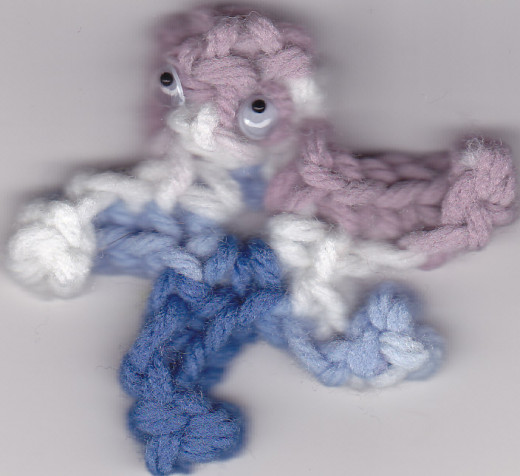
Update on latest craft fair experiences - 2015 and 2016
Well, we missed the November craft fair due to a lack of communication (she said she was going to get the space, and then forgot to sign up for it). The December one was very slow and I only sold 3 scarves and 4 pencil toppers (see picture). She only sold 5 books and 9 ornaments, but she also added some handmade clay jewelry (pendant on a cord) this year and sold 2 of those. She spent part of our "down time" (waiting for customers) putting together more jewelry (adding ends to the cords and stringing the pendants), which I think was a bit distracting for us (I helped with some) as we were not paying attention to the customers walking by in the hallway.
We froze the first day as it was cloudy and in the 30s outside. The next day the sun was out and we were baking until the sun went over the building and then we froze again. Didn't seem to make a lot of difference to wear "long johns" under our pants and layers of sweaters. We will have to think long and hard about doing a December one in the unheated hallway again.
In 2016 we tried the April craft fair date. That was a big mistake. We both decided that people had no money after the holidays (Thanksgiving and Christmas), so no one was buying what we were trying to sell. The traffic was light and very few even stopped to look at my scarves, but did look at her books. The most traffic we had were friends of ours that stopped to talk. Even the other sellers were doing badly at this one. Some educations are a bit expensive, but lucky for us the craft fair table costs are not terribly high.
There are also several groups that try to "start" an annual craft fair by handing out flyers at this craft fair in hopes of getting vendors. The one problem I saw with the flyer I was handed was that they had too many rules and regulations attached to their small craft fair. Restrictions on table size (bring your own), types of items for sale, times to set up and tear down, etc. They wanted to strictly control the vendors so much that it was not worth the time and money to sign up with them. I hope they make changes next year so they have a better turn out.

